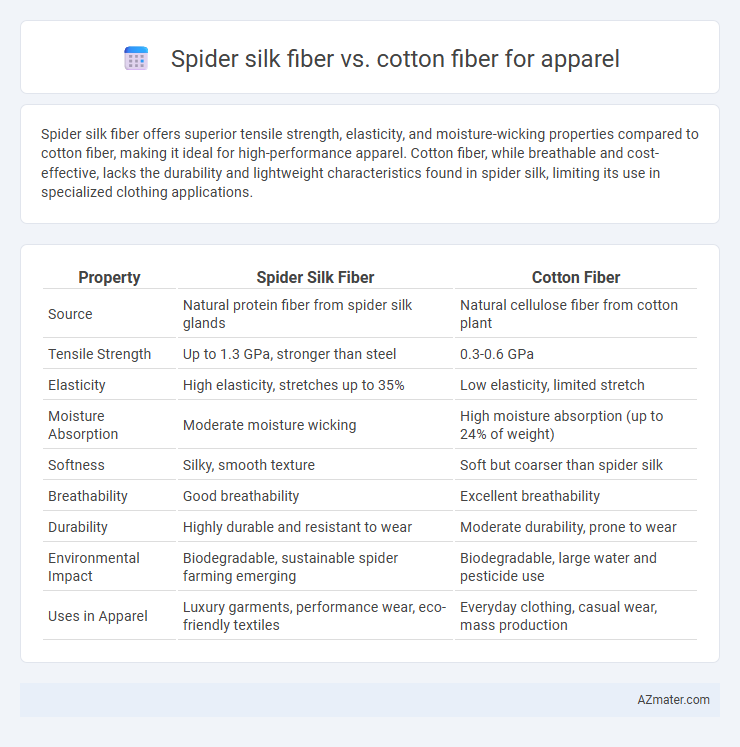Spider silk fiber offers superior tensile strength, elasticity, and moisture-wicking properties compared to cotton fiber, making it ideal for high-performance apparel. Cotton fiber, while breathable and cost-effective, lacks the durability and lightweight characteristics found in spider silk, limiting its use in specialized clothing applications.
Table of Comparison
| Property | Spider Silk Fiber | Cotton Fiber |
|---|---|---|
| Source | Natural protein fiber from spider silk glands | Natural cellulose fiber from cotton plant |
| Tensile Strength | Up to 1.3 GPa, stronger than steel | 0.3-0.6 GPa |
| Elasticity | High elasticity, stretches up to 35% | Low elasticity, limited stretch |
| Moisture Absorption | Moderate moisture wicking | High moisture absorption (up to 24% of weight) |
| Softness | Silky, smooth texture | Soft but coarser than spider silk |
| Breathability | Good breathability | Excellent breathability |
| Durability | Highly durable and resistant to wear | Moderate durability, prone to wear |
| Environmental Impact | Biodegradable, sustainable spider farming emerging | Biodegradable, large water and pesticide use |
| Uses in Apparel | Luxury garments, performance wear, eco-friendly textiles | Everyday clothing, casual wear, mass production |
Introduction to Spider Silk and Cotton Fibers
Spider silk fiber, known for its exceptional tensile strength and elasticity, offers a lightweight yet durable material ideal for high-performance apparel. Cotton fiber, derived from the seed hair of the cotton plant, provides breathability, softness, and moisture absorption, making it a staple in everyday clothing. Comparing both fibers highlights spider silk's advanced mechanical properties against cotton's natural comfort and versatility in textile manufacturing.
Structural Composition of Spider Silk vs Cotton
Spider silk fiber consists primarily of fibroin proteins arranged in highly organized beta-sheet nanocrystals that provide exceptional tensile strength and elasticity, making it one of the toughest natural fibers. Cotton fiber is mainly composed of cellulose, a polysaccharide with a crystalline and amorphous structure that offers breathability, softness, and moisture absorbency but lacks the mechanical resilience found in spider silk. The unique hierarchical molecular alignment in spider silk enables superior durability and flexibility in apparel applications compared to the relatively simpler fibrous network of cotton.
Mechanical Strength and Durability Comparison
Spider silk fiber exhibits exceptional mechanical strength with a tensile strength up to 1.3 GPa, surpassing cotton fiber, which typically ranges between 0.2 to 0.5 GPa. The elasticity of spider silk allows it to stretch up to 30%, providing superior durability and resistance to wear compared to cotton's limited elongation at break of about 5-10%. These properties make spider silk an ideal material for high-performance apparel requiring enhanced strength and long-lasting fabric integrity.
Comfort and Breathability in Apparel Applications
Spider silk fiber exhibits superior comfort and breathability compared to cotton fiber due to its lightweight, fine diameter, and natural moisture-wicking properties that regulate body temperature effectively. Unlike cotton, spider silk maintains excellent breathability while being stronger and more durable, reducing fabric wear and enhancing long-term comfort in apparel applications. The natural elasticity and softness of spider silk contribute to a gentle, flexible fit that outperforms cotton in maintaining comfort throughout extended wear.
Moisture Management and Absorbency
Spider silk fiber outperforms cotton fiber in moisture management due to its hydrophobic properties, which allow it to repel water and dry quickly, enhancing wearer comfort during physical activities. Cotton fiber, while highly absorbent and capable of retaining moisture, tends to remain wet longer, leading to potential discomfort and reduced breathability in apparel applications. The superior moisture-wicking ability of spider silk fiber makes it an ideal choice for performance and technical clothing targeting active consumers.
Sustainability and Environmental Impact
Spider silk fiber exhibits superior sustainability compared to cotton fiber due to its biodegradability, low resource consumption, and minimal pesticide use during production. Cotton cultivation requires extensive water, fertilizers, and chemicals, contributing to soil degradation and pollution, whereas spider silk production relies on bioengineered processes that significantly reduce environmental footprints. The renewable nature and durability of spider silk fibers offer an eco-friendly alternative for apparel manufacturing, enhancing circularity and reducing carbon emissions in the fashion industry.
Biodegradability and End-of-Life Considerations
Spider silk fiber exhibits superior biodegradability compared to cotton fiber, breaking down naturally in soil without releasing harmful residues due to its protein-based composition. Cotton fiber, although natural and biodegradable, often involves pesticide residues and chemical treatments that can hinder its environmental decomposition and impact soil health. End-of-life considerations favor spider silk in sustainable apparel as it offers a more eco-friendly disposal option, reducing landfill accumulation and facilitating circular textile solutions.
Production Methods and Scalability
Spider silk fiber production relies on bioengineering techniques such as recombinant DNA technology and microbial fermentation to produce synthetic fibers, enabling controlled quality and sustainability but facing challenges in large-scale manufacturing. Cotton fiber is cultivated through traditional agricultural methods with well-established mechanized harvesting and processing systems, offering high scalability and cost-efficiency for apparel production. While cotton's scalability remains unmatched, advancements in synthetic spider silk production aim to overcome current limitations, potentially revolutionizing sustainable textile manufacturing.
Cost Analysis and Market Availability
Spider silk fiber offers superior tensile strength and elasticity compared to cotton fiber but remains significantly more expensive due to labor-intensive harvesting and limited production scalability. Cotton fiber benefits from well-established global supply chains and economies of scale, making it widely available and cost-effective for apparel manufacturing. Market availability of spider silk is currently niche and confined to high-end luxury applications, whereas cotton dominates mass-market apparel due to its affordability and abundant supply.
Future Prospects in Textile Innovation
Spider silk fiber offers exceptional tensile strength, elasticity, and biodegradability, making it a promising sustainable alternative to traditional cotton fiber in apparel. Innovations in bioengineering and recombinant protein technology aim to scale spider silk production, potentially revolutionizing textile manufacturing with lightweight, durable, and eco-friendly fabrics. Future prospects emphasize the integration of spider silk in high-performance activewear and luxury fashion, driven by increasing consumer demand for environmentally responsible and innovative materials.

Infographic: Spider silk fiber vs Cotton fiber for Apparel
 azmater.com
azmater.com